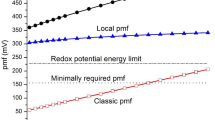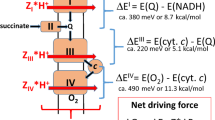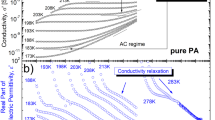Abstract
THE conversion of metabolic energy into useful work is a very efficient process in biological cells. The energy in ATP is transformed into mechanical, electrical and osmotic work at efficiencies which have been calculated to approach 100 per cent for acid secretion in the stomach1, active Na+ transport in frog skin2 and sartorius muscle contraction3. These observations show that energy is converted in biological cells by a process which is not limited by a Carnot efficiency factor (about 2 per cent in warm blooded animals). The process could involve electrochemical “cold” combustion, in which chemical energy is transformed into electronic potential energy, in much the same way as the operation of a fuel cell4. Accordingly, Mitchell5,6 likened the oxido/reduction and phosphorylation processes in his chemiosmotic hypothesis to a protonic fuel cell in which ATP synthesis was construed as a vectorial reaction driven by a “proton-motive” force across the mitochondrial membrane.
This is a preview of subscription content, access via your institution
Access options
Subscribe to this journal
Receive 51 print issues and online access
$199.00 per year
only $3.90 per issue
Buy this article
- Purchase on Springer Link
- Instant access to full article PDF
Prices may be subject to local taxes which are calculated during checkout
Similar content being viewed by others
References
Crane, E. E., and Davies, R. E., Biochem. J., 49, 169 (1951).
Ussing, H. H., Protoplasma, 63, 292 (1967).
Kushmerick, M. J., and Davies, R. E., Proc. Roy. Soc., B, 174, 315 (1969).
Bockris, J. O'M., and Srinivasan, S., Nature, 215, 197 (1967).
Mitchell, P., Nature, 191, 144 (1961).
Mitchell, P., Fed. Proc., 26, 1370 (1967).
Crane, E. E., and Davies, R. E., Trans. Farad. Soc., 46, 598 (1950).
Bockris, J. O'M., and Conway, B. E., Rec. Chem. Prog., 25, 31 (1964).
Glasstone, S., Laidler, K. J., and Eyring, H., The Theory of Rate Processes (McGraw-Hill, 1941).
Zwolinsky, B. J., Eyring, H., and Reese, C. E., J. Phys. Coll. Chem., 53, 1426 (1949).
Johnson, F. H., Eyring, H., and Polissar, M. J., The Kinetic Basis of Molecular Biology (Wiley, 1954).
Parlin, R. B., and Eyring, H., in Ion Transport Across Membranes (edit. by Clarke, H. T.) (Academic Press, 1954).
Bockris, J. O'M., and Reddy, A. K., Modern Electrochemistry: An Interdisciplinary Study, chap. 8 (Plenum Press, 1969).
Srinivasan, S., Wroblowa, H., and Bockris, J. O'M., Adv. Catal., 17, 352 (1967).
Myamlin, M., and Pleskov, Y., Electrochemistry of Semiconductors (Plenum Press, 1967).
Gutmann, F., and Lyons, L. E., Organic Semiconductors (Wiley, 1967).
Skou, J. C., Physiol. Rev., 45, 596 (1965).
Kasbekar, D. K., and Durbin, R. P., Biochim. Biophys. Acta, 105, 472 (1965).
Davies, R. E., Biol. Rev., 26, 87 (1951).
Moore, J. H., and Shechter, R. S., Nature, 222, 476 (1969).
Mandel, L. J., thesis Univ. of Pennsylvania (1969).
Taylor, R. E., Moore, J. W., and Cole, K. S., Biophys. J., 1, 161 (1960).
Cole, K. S., Membranes, Ions, and Impulses (University of California Press, 1968).
Hille, B., J. Gen. Physiol., 51, 221 (1968).
Brunton, W., thesis, Univ. Pennsylvania (1969).
Hodgkin, A. L., and Huxley, A. F., J. Physiol., 116, 449 (1952).
Cole, K. S., and Moore, J. W., J. Gen. Physiol., 44, 137 (1960).
Julian, F. J., Moore, J. W., and Goldman, D. E., J. Gen. Physiol., 45, 1232 (1962).
Dodge, F. A., and Frankenheuser, B., J. Physiol., 143, 83 (1958).
Author information
Authors and Affiliations
Rights and permissions
About this article
Cite this article
MANDEL, L. Active Ionic Transport across Biological Membranes: Possible Role of Electrons and Protons. Nature 225, 450–451 (1970). https://doi.org/10.1038/225450a0
Received:
Revised:
Issue Date:
DOI: https://doi.org/10.1038/225450a0
This article is cited by
-
Contribution to the electrochemistry of bimolecular lipid membranes
Biophysik (1973)
Comments
By submitting a comment you agree to abide by our Terms and Community Guidelines. If you find something abusive or that does not comply with our terms or guidelines please flag it as inappropriate.



